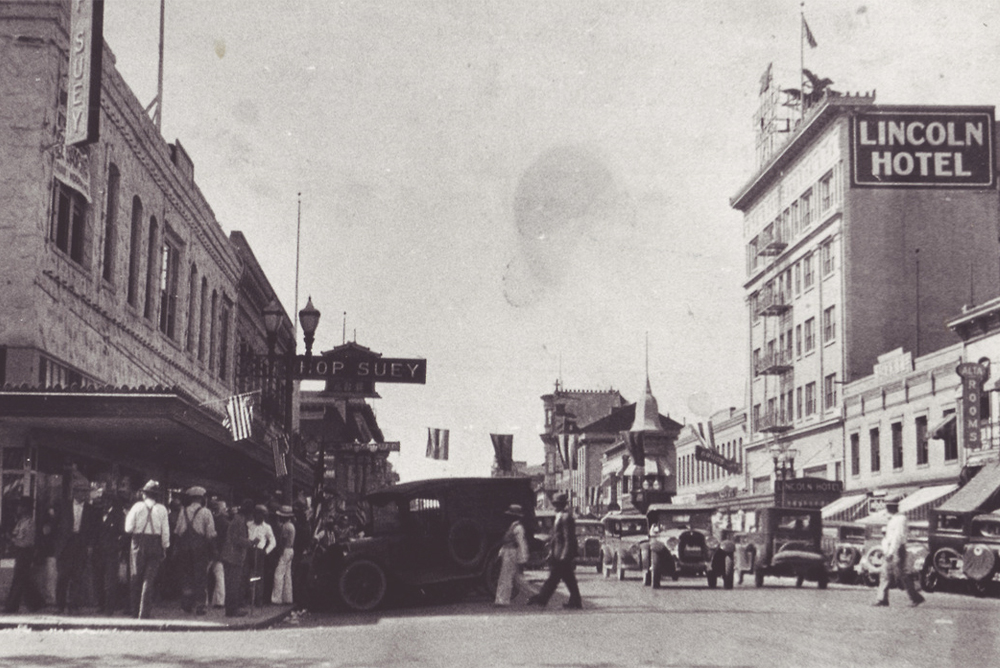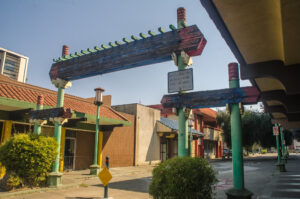
Stockton’s Asian enclaves (including Little Manila, pictured above, circa 1920s) occupied a five-by-five block area downtown. In the mid-20th century, redevelopment and the Crosstown Freeway displaced the neighborhoods. Photo by Frank Manaco, courtesy of the Filipino American National Historical Society.
What happened to Stockton’s first Asian enclaves?
In the 20th century, downtown Stockton established itself as a cultural and commercial hub for Chinese, Japanese, and Filipino communities in California’s San Joaquin Valley. But, over decades, misguided and racially biased projects deliberately destroyed this ethnically diverse and inclusive urban core.
Only recently have the city and state started to look into remedying the harm they did to the people of color who lived and worked in that five-by-five block of Stockton and made it home. This work, part of a larger national racial reckoning, includes exploring paths toward restorative justice in Stockton, such as a recent project by Caltrans, the state transportation agency behind the Crosstown Freeway, or State Route 4, which tore through the heart of downtown Stockton’s Chinatown, Japantown, and Little Manila neighborhoods in the 1960s and ’70s.
Asian immigrants first arrived in Stockton when it was a jumping-off point for the Gold Rush. Later, as the area established itself as a shipping and food processing hub for the Central Valley’s growing agricultural mega-economy, they came as farmworkers and low-wage laborers, along with their families. The work fueling the “nation’s breadbasket” was brutal and backbreaking, the type of employment that many whites refused to do. Alongside Latinos, Asians became a significant portion of this labor force by the early 1900s, building levees, farming the land, harvesting crops, and canning produce.
As the Asian population in Stockton grew, residents put down more permanent roots. Chinatown came first, in the 19th century, with several hundred residents building restaurants, hardware stores, grocery stores, and gambling houses; Japantown followed, boasting 150 businesses at its peak in the 1930s; and Little Manila came last, establishing a distinctive community all its own by the early 20th century with dance halls, barbershops, and grocery stores.
Each enclave was vibrant and distinct, but intersected with the others as well, creating a five-by-five block neighborhood flush with life, and filled with ethnic organizations, religious institutions, and communal gathering spaces. These communities forged a strong sense of home and belonging in Stockton. However, racial segregation and government policies created substandard living conditions. Discriminatory redlining laws prevented Asians from buying property in surrounding white neighborhoods, which meant they had to crowd into a tiny area. With few economic opportunities available to them, Stockton’s Asian population had to work low-wage jobs, and could often only afford to live in crowded low-cost boarding houses or poorly maintained hotels.
Despite the racial disparities they faced, community members experienced the enclaves as a vital home. Reflecting on Little Manila in the 1950s, one Filipina resident told us: “I never was fearful ever, of going down around the El Dorado Street area and its vicinity, because that, to me, was like the only place where I saw so many Filipinos, and it was like going home, you know, for a lot of Filipinos because that’s where they met long lost friends.”
But by the mid-20th century, people who did not live downtown considered the Asian enclaves to be “undesirable slums” that were contributing to what seemed to be a declining central business district. Meanwhile, white households and businesses left Stockton for the suburbs. Local officials could have invested in preserving and strengthening existing neighborhoods to prevent people from moving away. But it was easier and more convenient to scapegoat their Asian neighbors downtown, already weakened by decades of discrimination.
In 1956, under the banner of progress, the city of Stockton formed the West End Redevelopment Project. With a stated intention to make “a community of which its citizens can be proud, rather than apologetic,” it set out to “revitalize” downtown by clearing out the Chinese, Japanese, and Filipino enclaves, and replacing them with mainstream retailers.
It was around this time, too, that the Division of Highways, the state transportation agency, now known as Caltrans, was selecting a route for the proposed Crosstown Freeway—part of an unprecedented infrastructure development project to modernize the Golden State’s roadways.

A sign of Chinatown in downtown Stockton. Courtesy of Wayne Hsieh/Flickr (CC BY-NC 2.0).
The Crosstown Freeway would link Interstate 5 and Route 99, facilitating the movement of trucks between the two highways, and would connect the suburbs to downtown. The Division of Highways considered a number of options for the freeway’s placement, including one route through white neighborhoods north of downtown Stockton. But in the end, as in so many places around the state and country, the agency chose the path through communities of color, dooming the three Asian enclaves.
According to the Division of Highways’ 1958 Master Plan Study, the agency picked the route through the ethnic enclaves to help expedite the West End Redevelopment Project’s plans to raze Stockton’s “slums” in favor of mainstream commercial development. The choice was also politically expedient; the agency knew Asian American residents lacked the knowledge, expertise, and political power to fight city hall, state agencies, and federal funders to stop the “progress” that would disproportionately impact their communities.
The one-two punch of redevelopment and the building of the Crosstown Freeway destroyed hundreds of homes, and displaced over a thousand people living in the Asian enclaves. Such losses were not just physical. Losing Little Manila, Chinatown, and Japantown meant an end for community—shuttering gathering places such as stores, cultural centers, and social clubs that had drawn people together from throughout the region.
Residents of Stockton’s Asian enclaves had no choice but to disperse, throughout San Joaquin County and beyond. Some fought to rebuild what they had lost downtown, but it was an uphill battle. Japanese Americans raised money to relocate the Buddhist Church of Stockton, for instance, but moving it away from its original central downtown location severed its historical and spiritual ties to Japantown. The Chinese community built the Lee Center in 1970 on Washington and El Dorado Streets, hoping to create a symbol of Chinese presence in Stockton and to replace low-income housing and commercial space that had been destroyed by the freeway. But financial difficulties forced it to close after only a few years of operation. The Filipino community had somewhat more success, building the Filipino Center in 1972 to restore lost housing and commercial space, and banded together to help those most impacted by the freeway, like the manongs, elderly male farm laborers who’d made Little Manila their home.
Today, Asian organizations in Stockton such as Little Manila Rising and the Chinese Benevolent Association still fight to tell their history, and rebuild the essence of what was lost. Amid recent demands for racial justice throughout the nation, government agencies—including Caltrans—are also talking about remedying past harms. Caltrans has proposed a Stockton Downtown Transformation Project to revitalize Asian enclaves in Stockton that the Crosstown Freeway upended. In a big step, the agency is acknowledging its role in bisecting communities north and south of the freeway.
In the past, officials excluded the Asian community from having a meaningful voice and role in government plans. This time around, Caltrans promises to “collaborate with the downtown communities such as… Little Manila Rising” to provide “improvements that will help restore the once vibrant cultural identity and community.”
It’s too early to know if such rhetoric will prove to be tokenism or materialize as real restorative justice. Seeking redress will take grassroots efforts by community groups and businesses—and the cooperation of the same state agencies that tore through these neighborhoods in the first place.




Send A Letter To the Editors